Apple iPad mini with Retina Display: Reviewed
by Anand Lal Shimpi on November 16, 2013 8:00 AM ESTThe SoC
The iPad mini with Retina Display rounds out the three platforms that use Apple’s A7 SoC. Although both the iPad Air and iPhone 5S use the A7, the mini’s implementation is closer in nature to the iPhone. The iPad mini’s SoC has always used the same package-on-package (PoP) assembly as the iPhone, with DRAM stacked on top of the SoC itself (1GB in this case). The benefit is obviously a reduction in board area, the downsides have to do with cost and thermals. That’s the first similarity between the mini’s A7 and the iPhone’s A7.
The second is one of frequencies. While the iPad Air’s A7 runs its two Cyclone CPU cores at up to 1.4GHz, the SoC in the iPad mini and the iPhone 5S runs at up to 1.3GHz. That might sound like a minor difference, but it’s far more pronounced when you look at what happens to frequency when you’re running heavy workloads.
Once again I turn to a fairly heavy CPU workload to plot performance over time. This is a multithreaded workload, slightly modified from what we used in the iPad Air review, designed to make the CPU cores consume max power. The scale is linear and the workload is the same across all devices, so what you’re effectively looking at is a graph of thermally bound CPU performance over time across all three A7 implementations:
Being the largest device (and the only device with a metal heat spreader and no DRAM stacked on top), the iPad Air obviously maintains the highest frequencies for the duration of the test. The iPhone 5S, with a significant reduction in internal volume (and a PoP SoC) reduces its CPU frequencies early on in order to keep skin temperature down and properly manage thermals. The iPad mini with Retina Display falls between the two, with its performance curve more closely following that of the iPhone 5S.
Although the mini has a similar max operating frequency to the iPhone 5S, it is a faster device thanks to it being less thermally constrained. Similarly, the iPad Air can be much faster than its clock speed would otherwise imply. If you’re wondering why Apple has been so focused on building its own SoCs and CPU architectures, this is the reason why. There’s a fixed amount of power you can dissipate in the form of heat in these mobile devices while still maintaining a good user experience. Performance per watt is the gating metric for success in mobile, and shipping high IPC/low frequency dual-core SoCs at 32/28nm is the best optimization available to a company like Apple today.
As you’d expect, our browser based CPU tests show the mini’s A7 performing in between the iPhone 5S and iPad Air. None of these tests are anywhere near as stressful as our thermal test from above, so we don’t see exaggerated differences in performance between the platforms. For most, I suspect you won’t notice a huge performance difference between the mini and Air. Those who are heavier users (e.g. audio mixing, 3D gaming, etc…), there will be a performance difference between the two iPads.
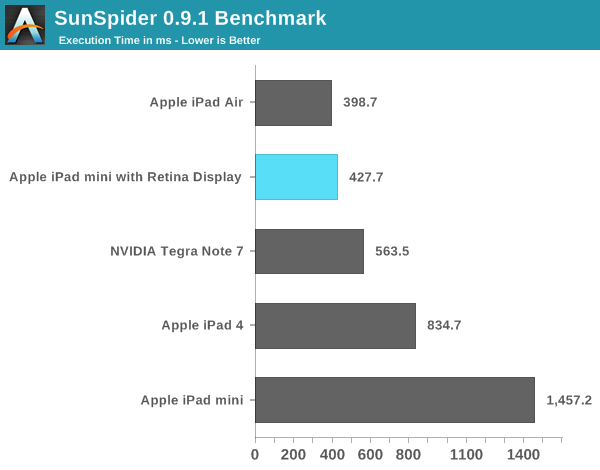

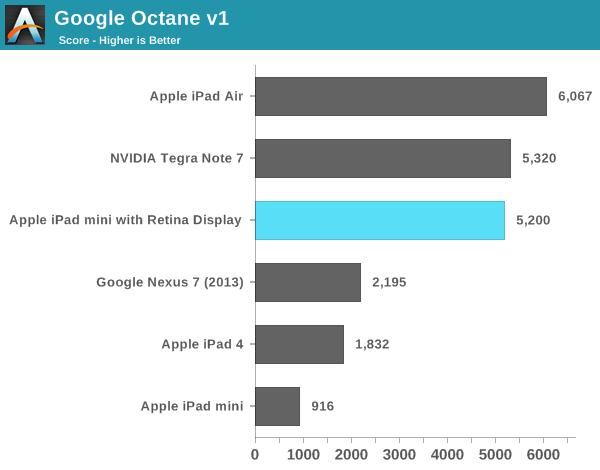
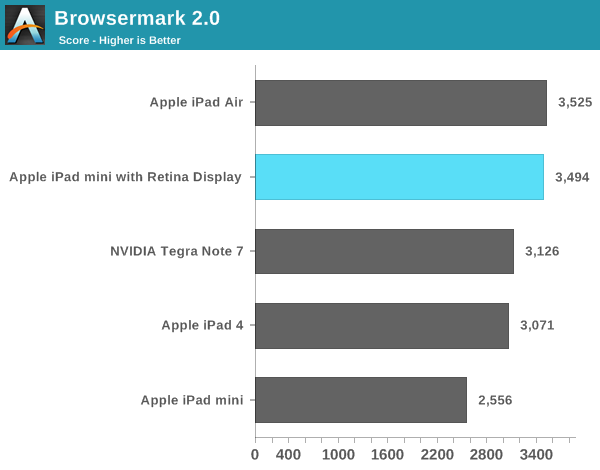
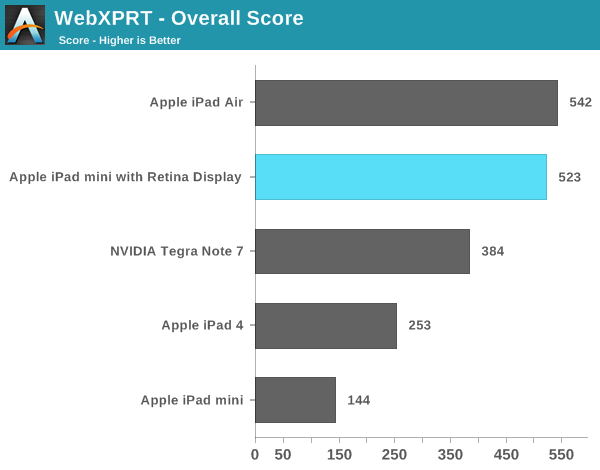
Compared to the first generation iPad mini, the new model is in a completely different performance league. Keep in mind the first mini used Apple’s A5 SoC based on an ARM Cortex A9. That’s the same single threaded performance as what’s in an iPhone 4S, and under iOS 7 it’s clearly running into some performance limits. The new mini with Retina Display however is a completely different animal. It’s fast.
Even comparing to the 4th generation iPad, the new mini is noticeably quicker.
Memory Bandwidth
Looking at the iPad mini’s memory bandwidth curve, we see it tracks very closely with that of the iPhone 5S. This is a slightly modified version of our previous bandwidth test, and you can see peak usable memory bandwidth (from the CPU’s perspective) of around 10GB/s. The ~12GB/s area right before you get out to main memory is bandwidth to the A7’s 4MB system-wide cache that sits after the shared L2 and the memory controller. This cache appears to service CPU, GPU and ISP requests at least.
GPU Performance
I believe the A7’s PowerVR G6430 GPU runs at around 450MHz. This frequency appears unchanged across all three A7 implementations. Once again, the big difference is how much thermal headroom exists in the platform which has an impact on overall performance.
Kishonti’s low level GPU performance tests back up my assertion that GPU frequency is fixed across all A7s. The iPad mini with Retina Display delivers equal performance to the iPad Air. The bigger news here is that nearly all of the GPU bound 3D tests seems to peg the mini and Air as equals. These are some pretty intense tests, but it looks like on the GPU side there’s no significant throttling when running at full tilt.
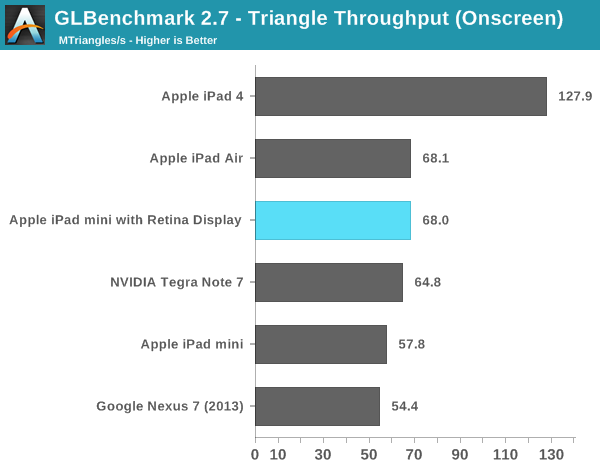

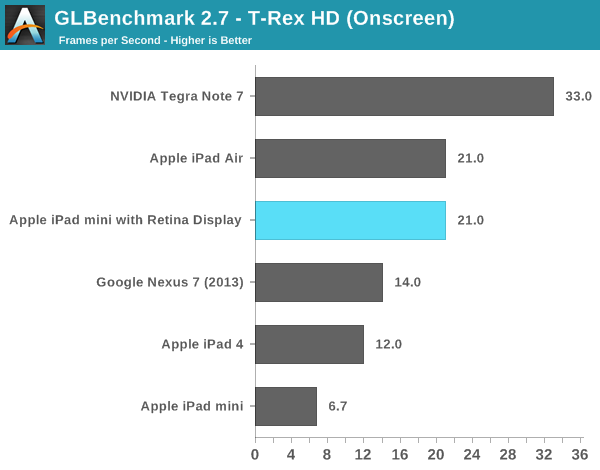

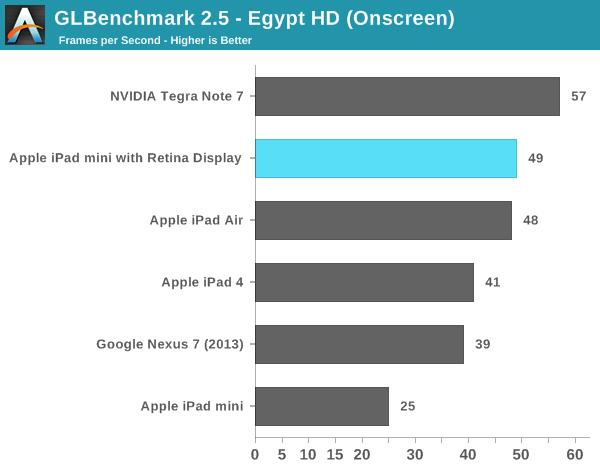
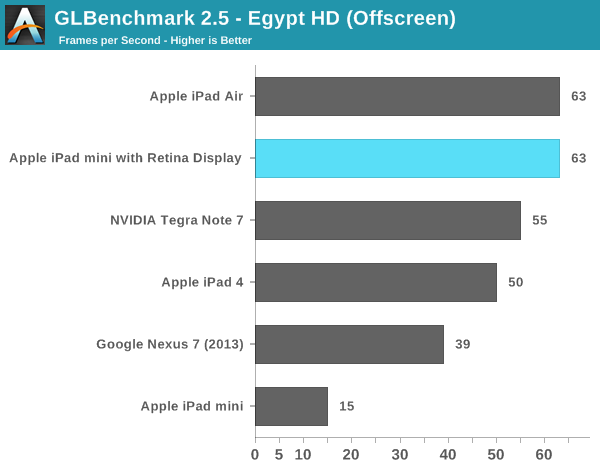
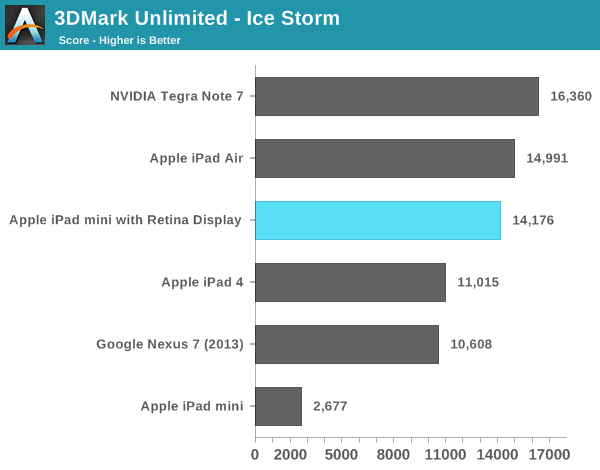
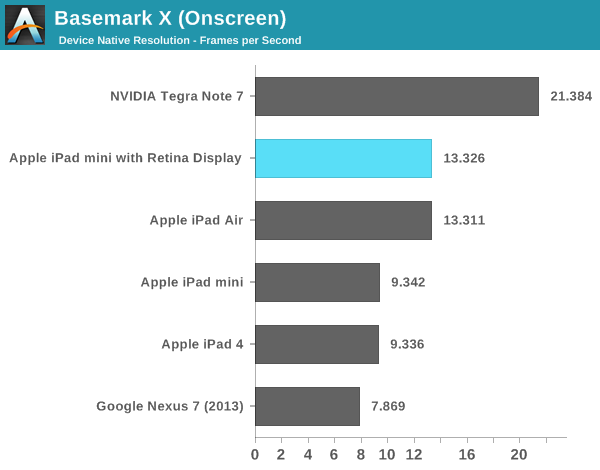
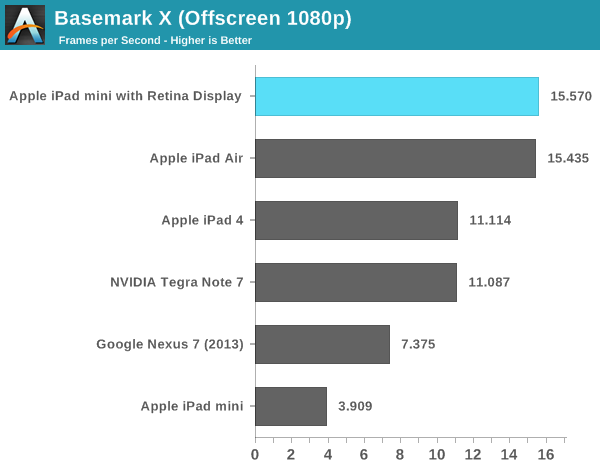
As I mentioned in our iPad Air review, despite having less peak theoretical memory bandwidth than the A5X/A6X, the A7 in the iPad mini never seems to regress in performance compared to even the iPad 4. Across the board the mini appears to be faster, more responsive and have more performance on tap than any prior iPad (big or small). The comparison to the original iPad mini is of course night and day. Even looking at lighter tests like the old GLBench Egypt HD benchmark, the iPad mini with Retina Display manages to be nearly twice as fast as the original mini - all while rendering 4x the number of pixels.


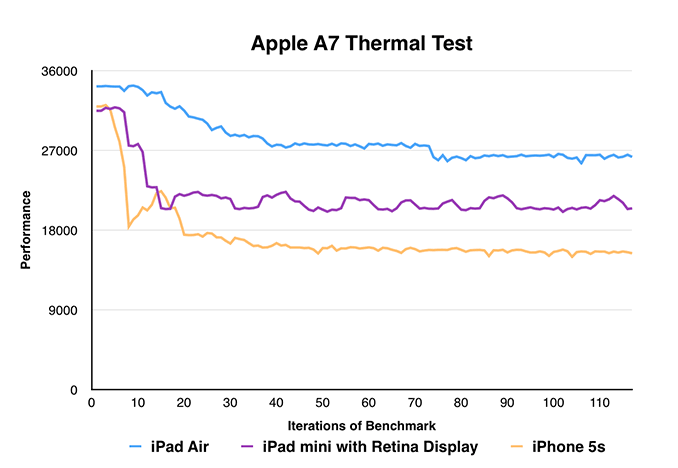
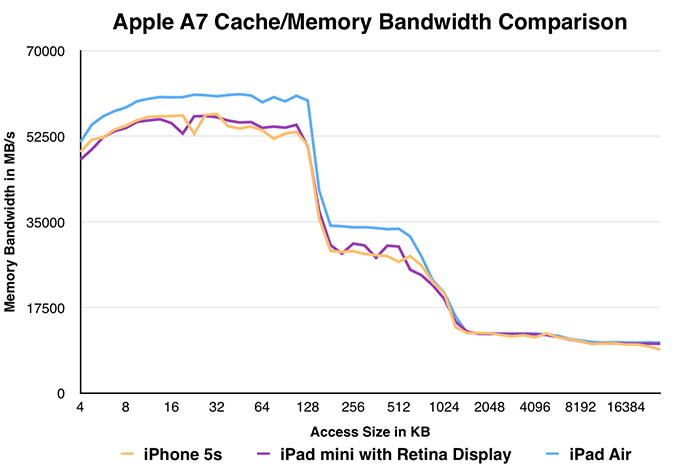








345 Comments
View All Comments
Puberticus - Saturday, November 16, 2013 - link
I'm truly puzzled.Why are you trying to turn this into a religious issue?
The review was concise and detailed. Why do you have a problem with that?
Apple produces superb products. Deal with it.
KoolAidMan1 - Sunday, November 17, 2013 - link
You Android fanatics are unbelievable. Anand backs up everything he says and in response there are so many irrational fanboy responses because he dare says that Apple makes the best option.He also doesn't give gold or silver awards in these reviews, you're crying over nothing.
erple2 - Monday, November 18, 2013 - link
An and doesn't actually say that Apple makes the best products, though. That's why I like this site. I'm an Android fan, but I appreciate the analysis of the products reviewed here. Interestingly, Apple fans are at least as rabid as Android fans. They make the same criticisms to justify their positions - pointing out how stuttery Android ran in the old days. Andre fans counter with how iOS is missing critical features in version 4. Either way, they're both right and wrong at the same time. Ultimately, each fan bought in to one camp or the other. I bought in to the Google ecosystem, and came into the smartphone market late, so I went with Android. Other people have had an iPhone since 2007, and are firmly in the iOS camp.I can't even remember why I started writing this. Oh also Anand was pretty glowing of the new nexus 7 on this article. But if you've invested money in the iOS camp, then it appears that the mini retina is the way to go.
zeagus - Monday, November 18, 2013 - link
Possibly, just possibly a better user experience and good tablet apps? Reality has a pro Apple bias when it comes to tablets right now.RadarTheKat - Monday, November 18, 2013 - link
Simple recognition that Apple is in a different class. All by itself. And Apple deserves that accolade given the detail and quality put into their products. Do you recall the delaminating issue with the first Nexus 7? That's a heck of a lot worse issue than the antenna issue on the iPhone 4 or the Apple Maps issues. I mean, the darn thing started coming apart!socio-statistical - Monday, November 18, 2013 - link
So, basically, you are saying, either they SKEW their reviews into Fantasy-land, or you won't listen. Interesting viewpoint there...p_giguere1 - Saturday, November 16, 2013 - link
1) Why would he "admit" an opinion as if it was an absolute fact? Anand clearly mentioned the Nexus 7 was a great option at the end and that it came to personal preference. Are you not satisfied he didn't say something like "You should suggest everybody you know a Nexus 7 over this because it's definitely a better buy for everyone"? What if that's a statement he disagrees with? You should review your definition of admission.2) The main thing the Nexus has going for it over an iPad is the price, and not everybody has a problem paying $400 for a tablet if they know they're getting high quality without compromises. Please don't allude first-time buyers necessarily have a low budget or low expectations. Their decision is sometimes more like "Should I get a tablet at all" rather than "What model should I get". They may feel only a truly good tablet would be worth trying to integrate in their current workflow/life which is currently fulfilled with other good gadgets. They need the tablet to be good enough to justify its frequent usage.
3) The absolute quality of a product may have more importance to some than the quality/price ratio when comparing products that are all within one's budget. By your logic, why wouldn't one suggest an even cheaper tablet than the Nexus 7? Value is almost always better for cheap products, so where do we set the bar? Why would you not suggest, say a $129 Hisense Sero Pro? After all, it has a similar form factor, IPS display, decent specs and runs Jelly Bean and the same apps. Why would anybody pay the 78% premium for the Nexus 7 when a cheaper tablet does all the same things for cheaper? See what I'm doing here?
Honestly you just seem mad Apple are getting the good reviews they deserve. This and the iPad Air are solid products. So is the Nexus 7. Can't be just accept that without turning it into a pissing contest?
solnyshok - Saturday, November 16, 2013 - link
I am the person who doesn't mind paying $400 for an uber 8" device. In fact, even EUR 400. However, at this price, iPad Mini Retina is a one huge glaring walking compromise. 16GB is not acceptable for a tablet at the end of 2013. In fact, the minimum memory I can live with now is 32GB for a phone and 64GB for a tablet. At 64GB, iPad Mini is 600 EUR here. I think I would rather have a much more reasonably priced LG G Pad 8.3 (EUR 350)+ 64GB Micro SDXC card(EUR 50)p_giguere1 - Saturday, November 16, 2013 - link
"Über" is relative apparently. At the end if the day, you still picked a device that you thought had better a value rather than judging on quality alone. Not that it's a bad thing, but let's not act as if everyone had the same budget and call one device objectively better when its main selling point is its value despite being objectively worse in certain easily measurable aspects.ws3 - Saturday, November 16, 2013 - link
So all you have to do is go buy your LG G Pad 8.3 and (hopefully) be happy with your purchase.Personally I don't need any more than 16GB on any mobile device. I've purchased 3 generations of iPhones and one iPad, and I've been satisfied with 16GB. Needless to say, I have had the option of going with higher flash sizes, but I haven't felt the need to do so.
Therefore, you can go buy your LG and have your fun with it, while I will go buy my iPad Air and have my fun with it. Win-Win.